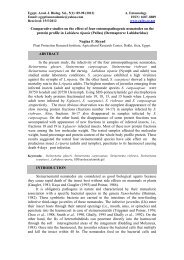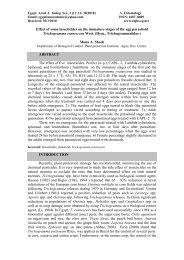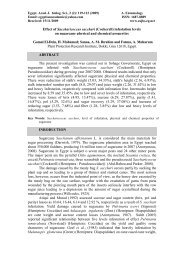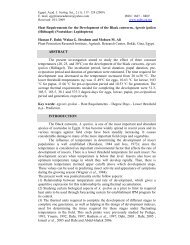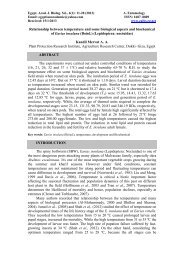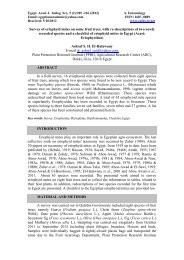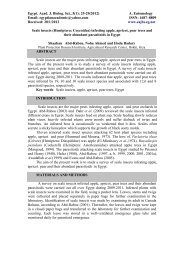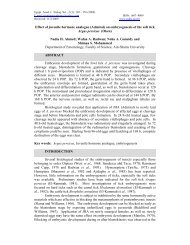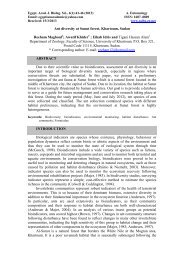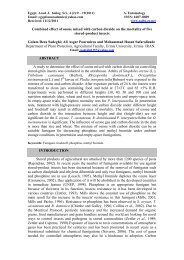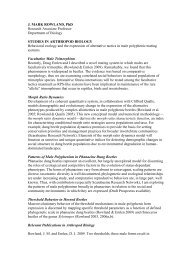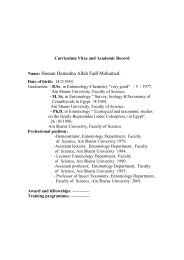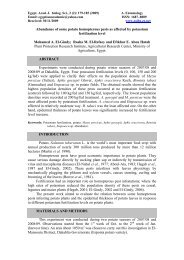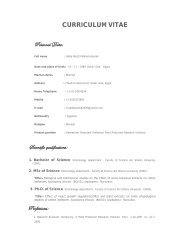Comparison of RAPD and PCR-RFLP markers for classification and ...
Comparison of RAPD and PCR-RFLP markers for classification and ...
Comparison of RAPD and PCR-RFLP markers for classification and ...
Create successful ePaper yourself
Turn your PDF publications into a flip-book with our unique Google optimized e-Paper software.
<strong>Comparison</strong> <strong>of</strong> <strong>RAPD</strong> <strong>and</strong> <strong>PCR</strong>-<strong>RFLP</strong> <strong>markers</strong> <strong>for</strong> <strong>classification</strong> <strong>and</strong> taxonomic studies 191<br />
Intraspecific variation (within each species):<br />
The average percentages <strong>of</strong> monomorphic b<strong>and</strong>s within each species are<br />
shown in Table (1). Among all species, the average percentages <strong>of</strong> monomorphic<br />
b<strong>and</strong>s were 67.0% <strong>and</strong> 61.0% <strong>for</strong> <strong>RAPD</strong> <strong>and</strong> <strong>RFLP</strong> analyses, respectively (Table 2).<br />
These overall similarity values indicated the detectability <strong>of</strong> polymorphism with the<br />
two kinds <strong>of</strong> molecular marker systems. The intraspecific variation within the three<br />
ant species, C. maculatus, M. pharoensis <strong>and</strong> C. bicolor, was shown in Table (1).<br />
Interspecific variation (between species):<br />
The average percentages <strong>of</strong> monomorphic b<strong>and</strong>s between species are shown in<br />
Table (2). Between all species, the average percentages <strong>of</strong> monomorphic b<strong>and</strong>s were<br />
33.0% <strong>and</strong> 39.0% <strong>for</strong> <strong>RAPD</strong> <strong>and</strong> <strong>RFLP</strong> analyses, respectively (Table 2). The average<br />
percentages <strong>of</strong> polymorphic b<strong>and</strong>s were higher between M. pharoensis <strong>and</strong> C.<br />
maculatus (18.4% <strong>and</strong> 15.8% <strong>for</strong> <strong>RAPD</strong> <strong>and</strong> <strong>RFLP</strong>, respectively) than between M.<br />
pharoensis <strong>and</strong> C. bicolor (9.3% <strong>and</strong> 14.8% <strong>for</strong> <strong>RAPD</strong> <strong>and</strong> <strong>RFLP</strong>, respectively) <strong>and</strong><br />
between C. maculatus <strong>and</strong> C. bicolor (11.3% <strong>and</strong> 5.4% <strong>for</strong> <strong>RAPD</strong> <strong>and</strong> <strong>RFLP</strong>,<br />
respectively) (Table 2). These overall dissimilarity values indicated the detectability<br />
<strong>of</strong> polymorphism with the two kinds <strong>of</strong> molecular marker systems. The interspecific<br />
variation between the three ant species, C. maculatus, M. pharoensis <strong>and</strong> C. bicolor,<br />
was shown in Table (2).<br />
Phylogenetic analyses:<br />
Phylogenetic analyses have been per<strong>for</strong>med on the <strong>RAPD</strong> results <strong>and</strong> <strong>RFLP</strong><br />
results as well as <strong>for</strong> the data <strong>of</strong> <strong>RAPD</strong>+<strong>RFLP</strong> (Fig. 3). <strong>RAPD</strong>, <strong>RFLP</strong> <strong>and</strong><br />
<strong>RAPD</strong>+<strong>RFLP</strong> data.<br />
C. maculatus<br />
M. pharoensis<br />
A<br />
C. bicolor<br />
C. maculatus<br />
C. bicolor<br />
M. pharoensis<br />
C<br />
9 10 11 12 13 14 15 16 17<br />
Linkage Distance<br />
Linkage Distance<br />
Linkage Distance<br />
Fig. 3: Dendrograms constructed on the basis <strong>of</strong> similarity index among three ant species, C.<br />
maculatus, M. pharoensis <strong>and</strong> C. bicolor using data <strong>of</strong> <strong>RAPD</strong>, <strong>PCR</strong>-<strong>RFLP</strong> <strong>and</strong> <strong>RAPD</strong>+<strong>PCR</strong>-<br />
<strong>RFLP</strong>. A: <strong>RAPD</strong>, B: <strong>PCR</strong>-<strong>RFLP</strong> <strong>and</strong> C: <strong>RAPD</strong>+<strong>PCR</strong>-<strong>RFLP</strong>.<br />
Amplification with 40 r<strong>and</strong>om primers generated 603 monomorphic b<strong>and</strong>s <strong>and</strong><br />
297 polymorphic b<strong>and</strong>s in a total <strong>of</strong> 900-b<strong>and</strong>ed <strong>RAPD</strong> patterns. Whenever, <strong>RFLP</strong><br />
C. maculatus<br />
C. bicolor<br />
M. pharoensis<br />
B<br />
9 10 11 12 13 14 15 16 17<br />
9 10 11 12 13 14 15 16 17



